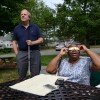I remember coming outside and blinking in the bright sun, looking at a gorgeous blue sky. On Sept. 11, 2001, I emerged from a meeting, clueless about what had happened just an hour or so earlier in New York City. As I walked to my car, I turned on my phone, which immediately started ringing. My sister’s voice was tight; I could feel her anxiety. “Where are you?” she asked. “Why?” I held my breath, fearing that the tension in her voice meant one of our close relatives had died.
And then she told me that two planes had rammed into New York’s Twin Towers. It was terrorism, she said, and nobody knew how many people had died. In the days after, we would hear of the many selfless acts, confirm the terrorism, and learn how the planned horror had links to Boston. That was 19 years ago this Friday.
Actually, I’ve been so immersed in the pandemic and its multi-pronged impact on my life that the 9/11 anniversary caught me off guard. I may have lost track of the date, but I won’t ever forget the television images of New Yorkers blinded by dense, gray smoke and debris stumbling through the rubble. Associated Press photographer Suzanne Plunkett was on the street capturing electrical engineer Stephen Cooper in mid-run — behind him, just a block away, the mushroom cloud of dust that was once the South Tower.
Cooper, who was 60 at the time, had been on his way to deliver a package in the building. For a long time, he didn’t know his picture had been taken until the photo became one of the iconic images of that day. For years, friends say, Cooper would point out his picture and marvel at his survival. But the man who outran a terrorist strike could not escape COVID-19. He died in early March at the age of 79.
This year’s 9/11 observance is especially sobering, a reality check that we won’t be able to outrun the pain and trauma of a virus which knows no boundaries. Nineteen years later, some of the losses of 2001 are sadly linked to 2020. Frontline workers who did the literal dirty work of New York’s recovery are vulnerable to COVID today because they were immuno-compromised from illnesses related to the toxic dust. Meanwhile, health care workers treating coronavirus victims are themselves falling victim to the infection. The website MedPage Today updates a list of the dead, while a project called Lost on the Frontline is trying to track real numbers — according to the project, more than 600 as of early June. And then I consider that back in April, the number of COVID deaths surpassed the 9/11 deaths. And that a new study revealed that COVID-19 is now the third-largest cause of death in the U.S., behind heart disease and cancer.
I didn’t think anything could rival the communal suffering and loss of 9/11, but here we are. For me, the most poignant part of the annual tributes in Boston and New York is when family and loved ones read out loud every one of the nearly 3,000 who died in 2001. Hearing the names is a powerful reminder of the real lives lost.
I’m contemplating the near-200,000 deaths and counting from the coronavirus. How will we honor their lives? Who will read their names?





